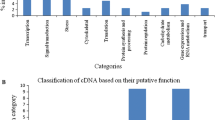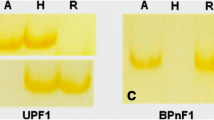Abstract
Generally, heading in Lolium perenne L. (perennial ryegrass) is associated with a reduction in the feed quality of the forage and therefore extending the period of vegetative growth during the growing season will contribute to an improvement in quality. The genetic control of floral transition has been well studied in model plant species but less research has been done in economically important crop species such as perennial ryegrass. A differential gene expression study was performed between two full sibling lines of L. perenne with contrasting flowering time. Suppression subtractive hybridization was used to identify 155 transcripts differentially expressed between the two sibling lines in the shoot apical meristem after primary and during secondary induction. Transcripts with a putative role in the floral transition were further characterized, through floral induction stages, by real time RT–PCR. This revealed five genes with greater than tenfold difference in expression between the lines during floral induction. Furthermore, a putative methyl binding domain protein and bHLH transcription factor were identified, which show clear differential expression patterns through floral induction and may act as potential enhancers of flowering in L. perenne.


Similar content being viewed by others
References
Andersen JR, Jensen LB, Asp T, Lubberstedt T (2006) Vernalization response in perennial ryegrass (Lolium perenne L.) involves orthologues of diploid wheat (Triticum monococcum) VRN1 and rice (Oryza sativa) Hd1. Plant Mol Biol 60:481–494
Anthony RG (2006) Signal transduction regulating floral development. In: Jordan BR (ed) Molecular biology and biotechnology of flowering. CABI, Oxfordshire
Armstead IP, Turner LB, Farrell M, Skot L, Gomez P, Montoya T, Donnison IS, King IP, Humphreys MO (2004) Synteny between a major heading- date QTL in perennial ryegrass (Lolium perenne L.) and the Hd3 heading-date locus in rice. Theor Appl Genet 108:822–828
Armstead IP, Skot L, Turner LB, Skot K, Donnison IS, Humphreys MO, King IP (2005) Identification of perennial ryegrass (Lolium perenne (L.)) and meadow fescue (Festuca pratensis (Huds.)) candidate orthologous sequences to the rice Hd1(Se1) and barley HvCO1 CONSTANS-like genes through comparative mapping and microsynteny. New Phytol 167:239–247
Baumbusch LO, Thorstensen T, Krauss V, Fischer A, Naumann K, Assalkhou R, Schulz I, Reuter G, Aalen RB (2001) The Arabidopsis thaliana genome contains at least 29 active genes encoding SET domain proteins that can be assigned to four evolutionarily conserved classes. Nucleic Acids Res 29:4319–4333
Berg A, Meza TJ, Mahic M, Thorstensen T, Kristiansen K, Aalen RB (2003) Ten members of the Arabidopsis gene family encoding methyl-CpG-binding domain proteins are transcriptionally active and at least one, AtMBD11, is crucial for normal development. Nucleic Acids Res 31:5291–5304
Bradley D, Ratcliffe O, Vincent C, Carpenter R, Coen E (1997) Inflorescence commitment and architecture in Arabidopsis. Science 275:80–83
Ciannamea S, Busscher-Lange J, de Folter S, Angenent GC, Immink RGH (2006) Characterization of the vernalization response in Lolium perenne by a cDNA microarray approach. Plant Cell Physiol 47:481–492
Desai S, Hill JE, Trelogan S, Diatchenko L, Siebert PD (2000) Identification of differentially expressed genes by suppression subtractive hybridization. In: Hunt SP, Livesey R (eds) Functional genomics: a practical approach. Oxford University Press, USA
Gendall AR, Simpson GG (2006) Vernalization. In: Jordan BR (ed) Molecular biology and biotechnology of flowering. CABI, Oxfordshire
Hannaway D, Fransen S, Cropper J, Teel M, Chaney M, Griggs T, Halse R, Hart J, Cheeke P, Hansen D, Klinger R, Lane W (1999) ‘Lolium perenne‘. PNW 502, Oregon State University, Pacific Northwest Extension
Hartmann U, Hohmann S, Nettesheim K, Wisman E, Saedler H, Huijser P (2000) Molecular cloning of SVP: a negative regulator of the floral transition in Arabidopsis. Plant J 21:351–360
Heide OM (1994) Control of flowering and reproduction in temperate grasses. New Phytol 128:347–362
Heim MA, Jakoby M, Werber M, Martin C, Weisshaar B, Bailey PC (2003) The basic helix-loop-helix transcription factor family in plants: a genome-wide study of protein structure and functional diversity. Mol Biol Evol 20:735–747
Hellemans J, Mortier G, De Paepe A, Speleman F, Vandesompele J (2007) qBase relative quantification framework and software for management and automated analysis of real-time quantitative PCR data. Genome Biol 8:2
Jackson JP, Lindroth AM, Cao XF, Jacobsen SE (2002) Control of CpNpG DNA methylation by the KRYPTONITE histone H3 methyltransferase. Nature 416:556–560
Jensen CS, Salchert K, Nielsen KK (2001) A TERMINAL FLOMER1-like gene from perennial ryegrass involved in floral transition and axillary meristem identity. Plant Physiol 125:1517–1528
Jensen CS, Salchert K, Gao CX, Andersen C, Didion T, Nielsen KK (2004) Floral inhibition in red fescue (Festuca rubra L.) through expression of a heterologous flowering repressor from Lolium. Mol Breed 13:37–48
Jensen LB, Andersen JR, Frei U, Xing YZ, Taylor C, Holm PB, Lubberstedt TL (2005) QTL mapping of vernalization response in perennial ryegrass (Lolium perenne L.) reveals co-location with an orthologue of wheat VRN1. Theor Appl Genet 110:527–536
Kojima S, Takahashi Y, Kobayashi Y, Monna L, Sasaki T, Araki T, Yano M (2002) Hd3a, a rice ortholog of the Arabidopsis FT gene, promotes transition to flowering downstream of Hd1 under short-day conditions. Plant Cell Physiol 43:1096–1105
Korzun V, Roder M, Worland AJ, Borner A (1997) Intrachromosomal mapping of genes for dwarfing (Rht12) and vernalization response (Vrn1) in wheat by using RFLP and microsatellite markers. Plant Breed 116:227–232
Li XX, Duan XP, Jiang HX, Sun YJ, Tang YP, Yuan Z, Guo JK, Liang WQ, Chen L, Yin JY, Ma H, Wang J, Zhang DB (2006) Genome-wide analysis of basic/helix-loop-helix transcription factor family in rice and Arabidopsis. Plant Physiol 141:1167–1184
Martin J, Storgaard M, Andersen CH, Nielsen KK (2004) Photoperiodic regulation of flowering in perennial ryegrass involving a CONSTANS-like homolog. Plant Mol Biol 56:159–169
Miernyk JA (1999) Protein folding in the plant cell. Plant Physiol 121:695–703
Miernyk JA (2001) The J-domain proteins of Arabidopsis thaliana: an unexpectedly large and diverse family of chaperones. Cell Stress Chaperon 6:209–218
Mylne JS, Barrett L, Tessadori F, Mesnage S, Johnson L, Bernatavichute YV, Jacobsen SE, Fransz P, Dean C (2006) LHP1, the Arabidopsis homologue of HETEROCHROMATIN PROTEIN1, is required for epigenetic silencing of FLC. Proc Natl Acad Sci USA 103:5012–5017
Ni M, Tepperman JM, Quail PH (1998) PIF3, a phytochrome-interacting factor necessary for normal photoinduced signal transduction, is a novel basic helix-loop-helix protein. Cell 95:657–667
Okada T, Endo M, Singh MB, Bhalla PL (2005) Analysis of the histone H3 gene family in Arabidopsis and identification of the male-gamete-specific variant AtMGH3. Plant J 44:557–568
Peng MS, Cui YH, Bi YM, Rothstein SJ (2006) AtMBD9: a protein with a methyl-CpG-binding domain regulates flowering time and shoot branching in Arabidopsis. Plant J 46:282–296
Petersen K, Didion T, Andersen CH, Nielsen KK (2004) MADS-box genes from perennial ryegrass differentially expressed during transition from vegetative to reproductive growth. Plant Physiol 161:439–447
Petersen K, Kolmos E, Folling M, Salchert K, Storgaard M, Jensen CS, Didion T, Nielsen KK (2006) Two MADS-box genes from perennial ryegrass are regulated by vernalization and involved in the floral transition. Physiol Plant 126:268–278
Qi Y, He X, Wang XJ, Kohany O, Jurka J, Hannon GJ (2006) Distinct catalytic and non-catalytic roles of ARGONAUTE4 in RNA-directed DNA methylation. Nature 443(7114):1008–1112
Simpson GG, Dean C (2002) Flowering—Arabidopsis, the rosetta stone of flowering time? Science 296:285–289
Singh K, Kumar S, Ahuja PS (2009) Differential expression of Histone H3 gene in tea (Camellia sinensis (L.) O. Kuntze) suggests its role in growing tissue. Mol Biol Rep 36(3):537–542. doi:10.1007/s11033-008-9211-x
Skot L, Humphreys MO, Armstead I, Heywood S, Skot KP, Sanderson R, Thomas ID, Chorlton KH, Hamilton NRS (2005) An association mapping approach to identify flowering time genes in natural populations of Lolium perenne (L.). Mol Breed 15:233–245
Thomas B, Carre I, Jackson S (2006) Photoperiodism and flowering. In: Jordan BR (ed) Molecular biology and biotechnology of flowering. CABI, Oxfordshire
Weber H, Bernhardt A, Dieterle M, Han P, Hano P, Mutlu A, Estelle M, Genschik P, Hellmann H (2005) Arabidopsis AtCUL3a and AtCUL3b form complexes with members of the BTB/POZ-MATH protein family. Plant Physiol 137:83–93
Yamada T, Jones ES, Cogan NOI, Vecchies AC, Nomura T, Hisano H, Shimamoto Y, Smith KF, Hayward MD, Forster JW (2004) QTL analysis of morphological, developmental, and winter hardiness-associated traits in perennial ryegrass. Crop Sci 44:925–935
Yamashino T, Fujimori T, Kato T, Mizuno T (2004) Analysis of PIF3 like bHLH proteins with reference to light signal transduction and clock function in Arabidopsis thaliana. Plant Cell Physiol 45:S69–S69
Yan L, Loukoianov A, Tranquilli G, Helguera M, Fahima T, Dubcovsky J (2003) Positional cloning of the wheat vernalization gene VRN1. Proc Natl Acad Sci USA 100:6263–6268
Yan LL, Loukoianov A, Blechl A, Tranquilli G, Ramakrishna W, SanMiguel P, Bennetzen JL, Echenique V, Dubcovsky J (2004) The wheat VRN2 gene is a flowering repressor down-regulated by vernalization. Science 303:1640–1644
Yano M, Katayose Y, Ashikari M, Yamanouchi U, Monna L, Fuse T, Baba T, Yamamoto K, Umehara Y, Nagamura Y, Sasaki T (2000) Hd1, a major photoperiod sensitivity quantitative trait locus in rice, is closely related to the arabidopsis flowering time gene CONSTANS. Plant Cell 12:2473–2483
Zemach A, Grafi G (2003) Characterization of Arabidopsis thaliana methyl-CpG-binding domain (MBD) proteins. Plant J 34:565–572
Zilberman D, Cao XF, Jacobsen SE (2003) ARGONAUTE4 control of locus-specific siRNA accumulation and DNA and histone methylation. Science 299:716–719
Acknowledgments
S. Byrne was funded by a Walsh Fellowship awarded by Teagasc, Ireland.
Author information
Authors and Affiliations
Corresponding author
Electronic supplementary material
Below is the link to the electronic supplementary material.
Rights and permissions
About this article
Cite this article
Byrne, S.L., Guiney, E., Donnison, I.S. et al. Identification of genes involved in the floral transition at the shoot apical meristem of Lolium perenne L. by use of suppression subtractive hybridisation. Plant Growth Regul 59, 215–225 (2009). https://doi.org/10.1007/s10725-009-9407-7
Received:
Accepted:
Published:
Issue Date:
DOI: https://doi.org/10.1007/s10725-009-9407-7




